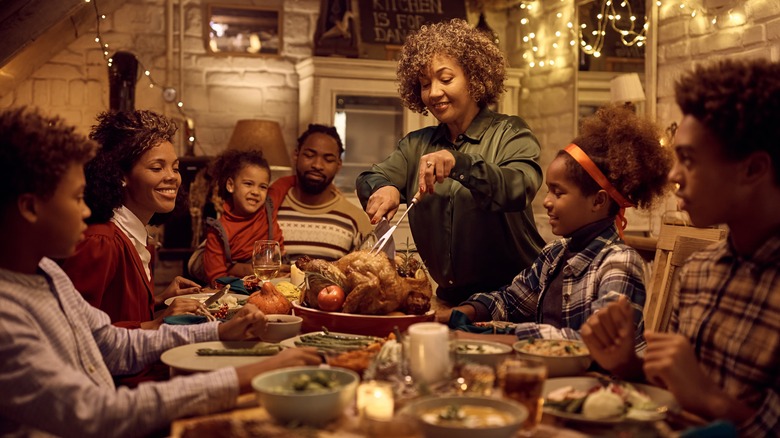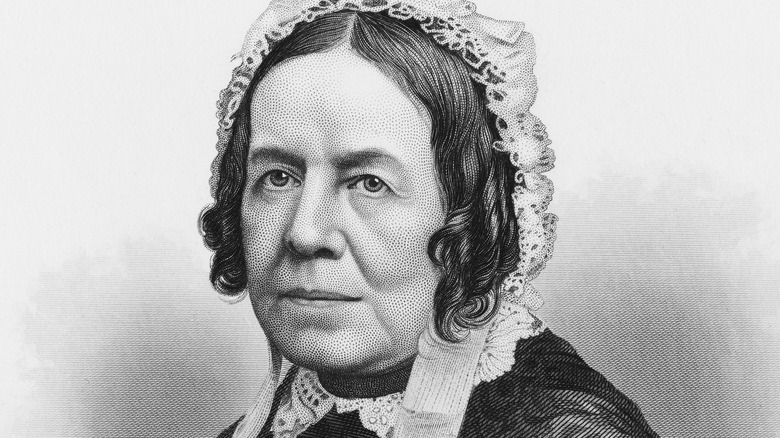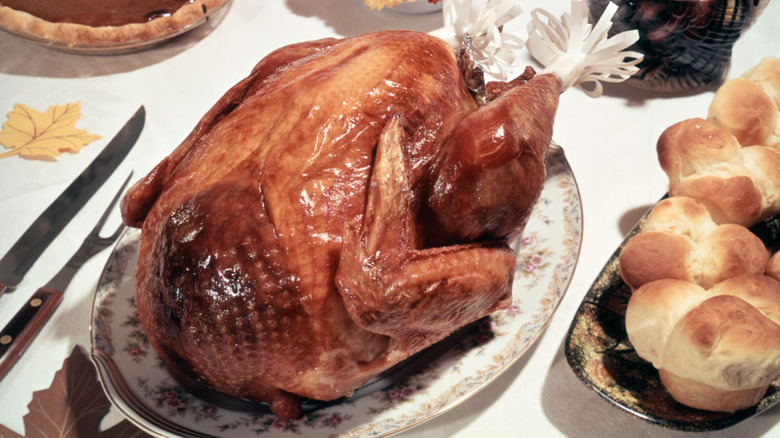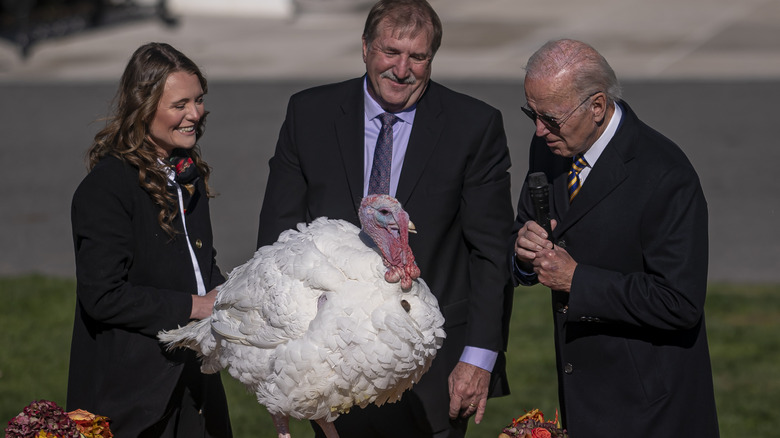How Turkey Became A Thanksgiving Tradition
A popular myth about American history concerns Benjamin Franklin and the turkey. The story goes that Franklin proposed the turkey as the national bird of the United States over the bald eagle. Alas for the turkey, it didn't get the job (nor did Franklin actually make that suggestion, per The Franklin Institute; he only privately compared the two birds and found the eagle wanting). But the gobbling bird of North America did find its way to becoming a fixture of U.S. iconography by way of Thanksgiving, where it is the go-to main course for families all over the country.
It hasn't always been that way. The feast of Thanksgiving held between pilgrims and Wampanoags in 1621 might have had turkeys; records indicate that the pilgrims provided "fowl" without specifying which kind according to Britannica. But it could just as likely have been duck or goose served during the feast. Per Real Simple, turkeys were exported back to Europe, where they were incorporated into native traditions of serving wildfowl with elaborate presentations, and back in America, they soon became a more popular meal than other birds. They were big enough to feed a family, there were plenty of them, and they didn't have any other value as livestock.
By the 1820s, Thanksgiving was not yet a national holiday, but turkeys had become a popular dish for local Thanksgiving celebrations. They were further popularized in that role through Sarah Josepha Hale's novel "Northwood," which gave a detailed description of a New England feast with a roast turkey as the featured dish.
The woman who popularized Thanksgiving turkey helped make it a national holiday
Sarah Josepha Hale's interest in Thanksgiving was more than literary. Per History, she had grown up with such a November celebration, which was a popular harvest festival in parts of America even without official recognition or an explicit link to the so-called "first Thanksgiving" at Plymouth. Nor was Hale the only writer who helped popularize Thanksgiving, and turkey as the holiday meal of choice. Writings by Plymouth colonists that referred to their Thanksgiving feast and to the ample flocks of turkeys in the New World were republished in the mid-19th century. Alexander Hamilton is said to have vouched for turkey as an ideal Thanksgiving dinner (per USA Today). And Charles Dickens' "A Christmas Carol" featured a plump Christmas turkey as a key plot element. Though a different holiday (and nationality), the novel did its part, according to some, to promote turkey dinners among its other accomplishments.
Hale went further than her peers, however, by campaigning to make Thanksgiving a national holiday. The idea had been around since George Washington's time as president, and Hale saw official recognition of such a holiday as a potential remedy to growing sectarian tensions in the 1800s. She wrote publicly in editorials on the subject, and privately to President Abraham Lincoln. He followed through with an official proclamation in 1863, fixing Thanksgiving as the fourth Thursday of November. By the time this official status was bestowed on the holiday, the iconography of pilgrims and turkeys was already taking shape thanks to literary efforts like Hale's and the reprints from Plymouth.
The turkey dinner has evolved over the years
Besides being big, plentiful, and gradually incorporated into popular images of the holiday's history, turkeys have another advantage as a Thanksgiving dinner: they're cheap. Per Britannica, turkeys have always been a reasonably priced bird for the family looking for a good holiday meal, and they became cheaper in the modern era. That trend hasn't been entirely interrupted; per The New York Times, turkey prices easily fluctuate, and a combination of tight supplies, inflation, and avian flu helped make them almost twice as expensive in 2022 as in 2021. But the importance of turkey to the Thanksgiving meal was so great that many families compensated by cutting back on the rest of the dinner instead of forgoing the main course.
If turkey prices have changed with time, so have the nature of the birds themselves. According to Real Simple, the turkeys served at Thanksgiving dinners up until the early 1900s tended to be wild fowl, much skinnier than the turkeys we eat today. Modern Thanksgiving turkeys are farm-raised, often in indoor lots, and are bred for ample breast meat.
Why do US presidents pardon turkeys?
There's always at least one turkey safe from the kitchen knife on Thanksgiving: the turkey given a pardon by the President of the United States. It's been claimed that Abraham Lincoln started this tradition in 1863, the very year he made Thanksgiving an official national holiday, but the White House Historical Association says that's probably not true. In the years immediately following Lincoln's proclamation, presidents were more likely to be gifted turkeys to eat than to spare, initially courtesy of a Rhode Island poultry man named Horace Vose and later from anyone who wanted to make a patriotic gesture in late November.
The Poultry and Egg National Board and the National Turkey Federation took over presenting the president with a bird during the Truman administration, and presidents from Harry Truman through Jimmy Carter sometimes regifted them to farms or zoos. By Ronald Reagan's time in office, sending the turkey on was standard practice. But it was only as recently as George H. W. Bush's time in the White House that presidents began conducting lighthearted pardoning ceremonies in view of the press.



